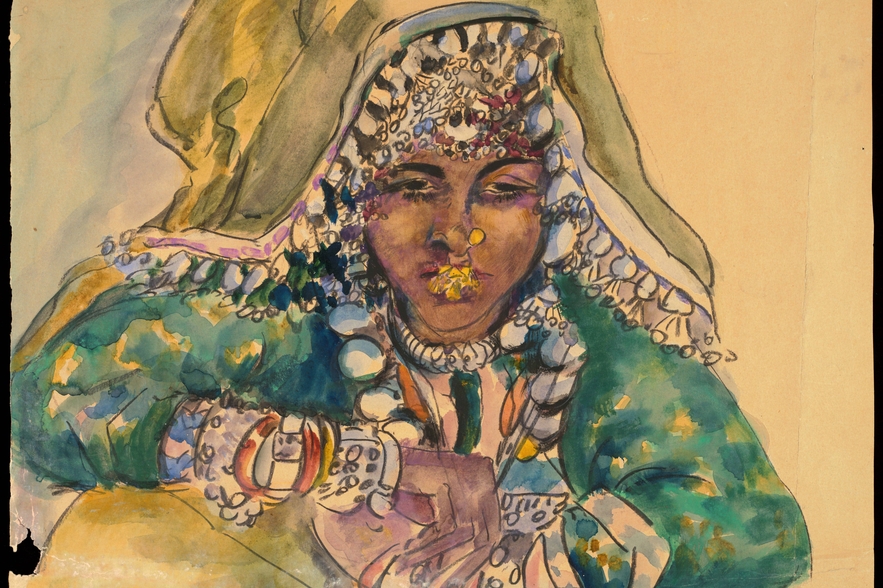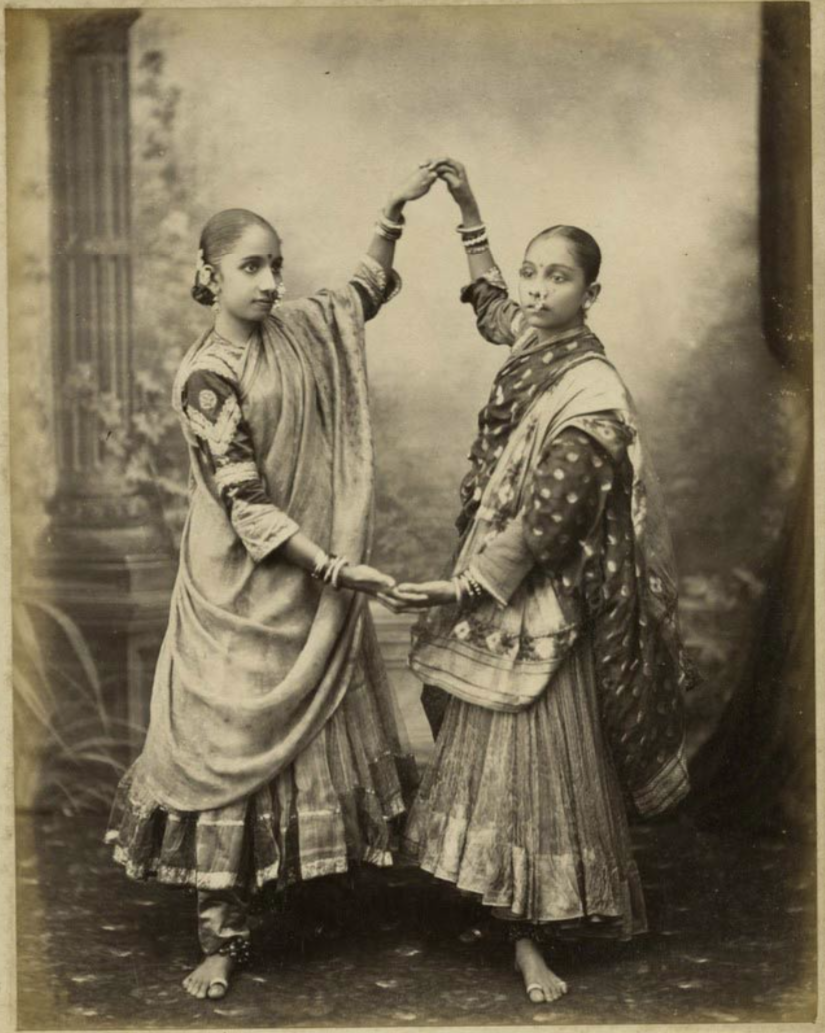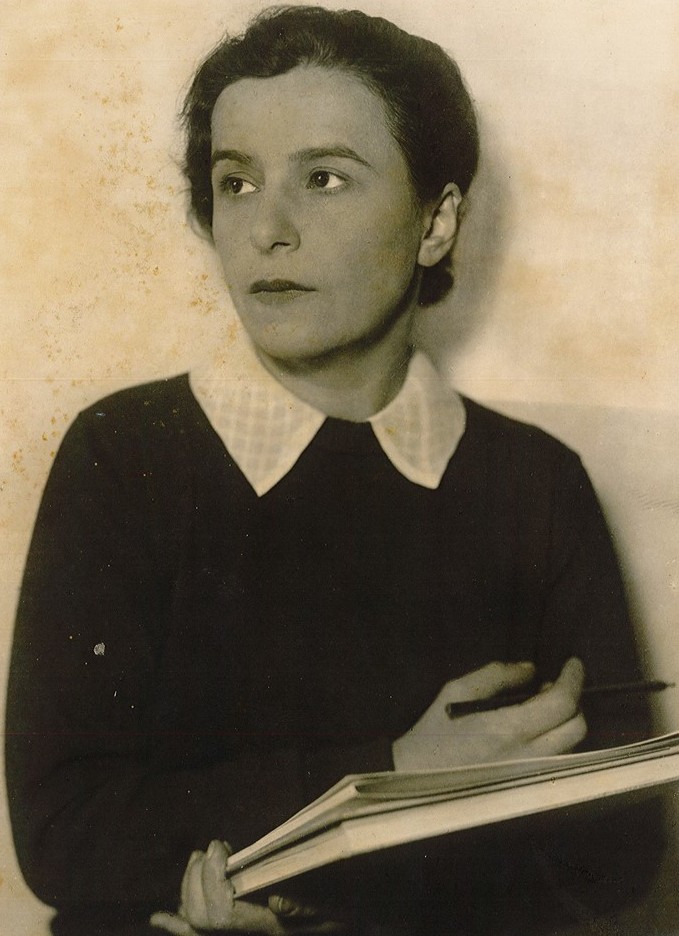Collection Highlight: Chuma, a Tawaif of Agra

- Autor
- Michael Simonson
- Datum
- Mi., 7. Feb. 2024
The collections of the Leo Baeck Institute contain numerous artworks. One of the artists most represented is Lene Schneider-Kainer. This Jewish artist, originally from Vienna but at the time based in Berlin, travelled from 1926 to 1928 across the Near East and Asia. A recently divorced woman, her journey was doubtless a brave undertaking for someone of her gender. She travelled with an entourage, including her new partner, the well-known German novelist Bernhard Kellermann. Later, in the Nazi period, she would flee Germany and eventually settle, after a long exile that led her through Spain and New York, to Bolivia. But at this time she was a successful artist who also ran her own fashion salon in central Berlin, where she circulated among high-society.
On her three year sojurn there were a few significant stops that lasted weeks or even months. One of these longer stops, in 1927, was in Agra, India. Here Lene spent time in a rented home with Kellermann and a staff of servants, drawing and painting local scenes and people. Among other things, Lene was very interested in painting a “real Indian courtesan,” what would be known in Agra and other cities in northern India as a Tawaif. Tawaifs had existed for centuries on the Indian subcontinent, where they might be comparable to the Japanese geisha. Lene’s mind was filled with tales of an older India, where such courtesans had held high prestige, but since the British occupation they had fallen into social and economic decline.
The patronage of the Mughal court before and after the Mughal Dynasty and the artistic atmosphere that developed in the 16th century in cities in the north of today’s modern India, such as Lucknow and Agra, made arts-related careers a viable prospect. Many girls were apprenticed at a young age into the royal courts, where they trained in the performing arts and literature, all with an eye to entertain and provide hospitality, for example at banquets, weddings among royalty, and festivals. In addition, they acted as educators. Young men of the upper classes were sometimes sent to a court where they observed the manners and hospitality exhibited by the Tawaifs, which they were to integrate into their own behavior. They also were taught about the arts. In addition to sharing already canonized works of music, dance, and literature, Tawaifs were trained to compose and create their own works. For instance, they taught such things as writing ghazals (a formal poetic form which originated in Arabian and Persian literature) or composing music to their pupils. The Tawaifs symbolized refined culture over the centuries. There was a sexual aspect to their lives, but they were not sex workers. A Tawaif was expected to remain unmarried but develop romantic / sexual relationships with patrons. They often served as a loyal mistress to a particular patron. The atmosphere was actually quite monogamous - only once a relationship was terminated, either due to the death of their patron or a mutual decision to part ways, would a Tawaif look to enter into another relationship. As historian and professor Veena Talwar Oldenberg, wrote in her book, The Making of Colonial Lucknow, "To relate Tawaifs to prostitution is an extremely corrupt portrayal of the institution.”
But things had changed for the Tawaifs by the time Lene arrived in Agra. The annexation of the region by the East India Company in 1856 was the first blow for this medieval-era institution, which now was looked upon with disfavour by the colonial government. Tawaif status declined over the next decades, their role being labeled by the British as sexually decadent, immoral, and sinful. Finally, most of theTawaifs were pushed into prostitution as a way to survive, lacking employment otherwise, and thus fulfilling the British accusations against them.
How much Lene knew the history of the Tawaif culture is not known, but she was aware of it and enchanted with their role in the India of times past. While in Amritsar only the week before she had purchased a number of traditional Indian miniatures. Doubtless these included images of Tawaif entertaining patrons and guests in the courts of the Mughal past. On her return to Agra she turned her eye to capturing in painting a Tawaif.

Agra, 28 November. I want to paint a dancing girl. I saw picture postcards of exquisite, slender creatures in gorgeous costumes and old jewelry. Consequently, they exist or they once did. Our chubby, congenial guide smiled, embarrassed. They certainly do exist, but he can’t take me there. Firstly, he is married – which wouldn’t be a hindrance. But the police forbid licensed guides to show those or similar places to strangers. The manager at our hotel offers his services. He’s not Hindu, but Muslim and single. He takes me directly to the police. But we’re out of luck. The man who would arrange it for me is away on leave. But there’s another police supervisor, also a Muslim, about two miles away. He can do it.
As it was considered immodest for women to visit such places on their own, Lene did what she often did during her journey– she dressed in male drag. In masculine attire it isn’t quite clear how she was perceived by the local population – did she pass as a man? - but the non-feminine look was enough to provide her access to spaces traditionally off-limits to women. There is a history of European and American women who travelled to the Near East and Asia who did similar. Lene arrives in a neighborhood, in male attire, where a Tawaif community now lives.
The girls are living along many streets in the middle of the bazaar; above the stores. They ruin us, declared the manager. Our young people spend their money, their strength and their health on these girls. We’re climbing up a narrow, dark, very steep staircase. Past a courtyard – 1.5 meters square – we reach a sort of a salon – rundown, dirty, destitute, empty. Through the half-open door I see three horribly fat, old women and several pretty, young girls playing cards. The girls are beautiful, but horribly dressed – half European – in knit cardigans and woolen scarves. After some palavering it is determined that they have not had their ceremony, i.e. they have not been deflowered. Hence, they can’t yet wear a dance costume or contract business.
The initiation ceremony being referred to here is called the Missi ceremony. Into the early 20th century, the initiation of a young girl into the Tawaif profession was a public celebration. A rich and well- connected patron, who paid quite a lot for the privilege, would be chosen to be the novice Tawaif's first lover. This sexual rite of passage also meant that the Tawaif now officially entered the world of hosting, composing, and performance in all the arts they had received training in.
In the subsequent decades, as the moral tirade against Tawaifs increased, the sexual initiation of a Tawaif was delinked from her initiation as a performer. While both rites happened around the same time, once a girl reached puberty it was the ceremony around her new role as a professional entertainer and host that was publicly celebrated. Meanwhile, her sexual initiation became a quieter, non-public affair. But though discreetly done, sexual initiation of a Tawaif with a chosen patron continued to be observed. Usually after this rite of passage a young Tawaif was allowed to have other lovers – indeed, the male patrons of the first night were expressly chosen for the price they would pay and the honor of being the first lover, but afterwards he asserted no claim on her. This was different for Tawaifs of the upper echelons of their society, who often were meant to bond with the chosen patron of the first night, and after the ceremony entered the role of professional mistress. This was based largely on class – upper class Tawaifs entering the role of mistress ideally for life, while the majority of Tawaifs of lower status having more patrons throughout their lives.
In her diary, Lene continues her description of meeting a Tawaif to paint.
The creature exudes a deeply moving beauty and sadness. It is hard to understand how these girls could land in such filthy surroundings...Unkempt, ragged. Her mouth deep red with rotted teeth; uncles, aunts, grandmother, children all crowd around a faintly glowing, deeply sad, bewitched princess. Her head tilted, she listens calmly to our requests. Her narrow, translucent child’s hand holds the cloth tight to her face. “You should have seen her four years ago!” says our companion who is watching her with compassion. Three or four large bundles are being dragged in. Precious, heavy, hand-embroidered dance gowns. Among them a blue one, richly embroidered with gold, with gold-brocade inserts. In a kind of medallion on the front, the inscription “Made for Chuma, Agra.” A maharaja deflowered, loved and venerated her until, for political and financial reasons, the English separated them. She has magnificent, old jewelry from him. In one room is a fireproof safe filled with jewelry and precious stones. All gifts from him. The key to the safe is not in the house. It has to be picked up at a relative’s house. She seems sad and indifferent when we are shown the precious items. She’s without joy, luster. I ask her if she loves the gifts, is attached to them. She purses her lips, bored and indifferent – couldn’t give a damn! The relatives are not disinterested, keen on sucking her dry as long as she’s breathing. They say she’s ill. Her melancholy, her depressive indifference are symptoms of ill health. She sings and dances every night, earns 600 rupees a night. There’s no festivity she’s not invited to. She is desired, adored. A high-ranking officer, my manager tells me, went perfectly mad when he saw her. We discussed what I would have to pay. She is silent. The family has the say. There’s bargaining. We’ve gone from 100, to 50 to 25 rupees per day. Then we explain that she will not have to dance or sing. Just sit. I will observe and draw her. I offer to pay 10 rupees. The family reacts as if they have to cover the shortfall. Chuma cuts them off in her guttural voice. “The memsab shall come, and I’ll sit for her.” Would I like tea? She feels my sympathy, my compassion. She would sit for me without being paid. I am certain.

The passage tells us a few things. First of all, we learn the name of this Tawaif is Chuma, which is Hindi for “Kiss.” Chuma still exerts a strong influence over her family and those around her. Though the family is engaged in making money from her performances, and perhaps in the past also was supported by her former patron, the Maharaja Lene hears about, Chuma in this passage makes the final decision to be painted. She has the power, the final say, and can silence her family if needed and make a decision on her own. Also, we learn she still has her jewelry, her decorative courtesan dancing outfits, and memories of her royal lover in the past – a lover that has now been separated from her by the British occupiers of the country.
In the following days, Lene visited the Tawaif area (dressed as a man) and painted Chuma outside in the courtyard. Around them the Tawaif culture continued in the neighborhood, now relegated, now largely sunken into poverty, but still present and alive. In her diary Lene records she painted Chuma three times. Chuma for her part sits silently in her courtesan costume, a relic of a community quickly passing in British India.
Among the work Lene Schneider-Kainer bequeathed the Leo Baeck Institute is one painting that I identify as Chuma. The loosely given title of it is “Girl in Agra,” and indeed this is where Chuma lived when she was painted. Further, she is the only image from India in our collections of a woman in a decorative, courtesan type costume. And lastly, in the Missi ceremony, when a girl loses her virginity to the chosen patron, she removes a nose ring that she has always had and it is replaced with a stud. In the painting I believe is of Chuma, we indeed see a solid gold stud in her nose.
Lene Schneider-Kainer in this painting captured a world that felt on the verge of disappearing. But we can also say today that Tawaif culture never completely disappeared. Some Tawaif went on to become popular composers, dancers, singers, and Bollywood stars in a new landscape of entertainment in British and then independent India. To be sure for most Tawaif life became increasingly difficult, entertaining smaller and smaller groups and engaging more directly in sex work as survival.
Today there is a new interest in Tawaif culture in India. In Lucknow, the Mahindra Sanatkanda Lucknow Festival is an organization that seeks to remember and revive the art, music, and literature of the world of the Tawaif. It is with thanks to members of this organization I have been able to provide a deeper context for this painting found in the collections of the Leo Baeck Institute.
Sources
Individuals
With special thanks to Madhavi Kuckreja, founder of the Mahindra Sanatkanda Lucknow Festival, which seeks to revive and preserve the traditional Indian arts and crafts of Lucknow, for all the information she provided about Tawaif culture.
Special thanks to her colleague, Saba Dewan, for further insights.
Printed Works
Oldenburg, Veena Talwar. The Making of Colonial Lucknow. 1856-1877. Princeton University Press. 2016.
Schneider-Kainer, Lene. Girl in Agra. Watercolor on paper. 1927. Call Nr. 79.335. Leo Baeck Institute.
Schneider-Kainer, Lene. Reisetagebuch 1926-1928: Persien - Indien - Siam - Himalaja – China. Call Nr. ME 1035. Leo Baeck Institute.
Aktuelles





